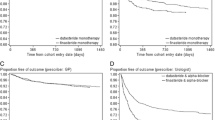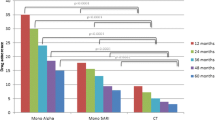Abstract
Introduction
Benign prostatic hyperplasia (BPH) is commonly treated with 5-alpha-reductase inhibitor/alpha blocker combination therapy or with alpha blocker monotherapy. However, in China, the characteristics of BPH patients receiving 5-alpha-reductase inhibitor/alpha blocker combination therapy or alpha blocker monotherapy remain largely unknown. Therefore, this study compared the characteristics of BPH patients receiving either the 5-alpha-reductase inhibitor finasteride in combination with an alpha blocker or an alpha blocker as monotherapy in clinical practice in China.
Methods
Data were obtained from a large electronic medical record database from four tertiary hospitals in major cities in China (2009–2016). BPH patients aged ≥ 50 years with ≥ 1 alpha blocker fill on/after the first BPH diagnosis were selected. Patients were further classified as receiving combination therapy (≥ 1 overlapping day of supply for finasteride and an alpha blocker) or alpha blocker monotherapy (did not receive any 5-alpha-reductase inhibitor). Patient characteristics, visit type (in- vs. outpatient) at treatment initiation, and comorbidities were evaluated during the 6-month baseline period and compared between the two groups using two sample t tests and chi-square tests/Fisher’s exact tests.
Results
A total of 2666 and 2738 patients received combination therapy and monotherapy, respectively. The combination group was older (70.3 vs. 67.3 years, p < 0.0001) and had more patients initiated in an inpatient setting (46.0% vs. 26.4%, p < 0.0001). Compared with the monotherapy group, the combination group had more comorbidities, such as hypertension (48.3% vs. 35.6%, p < 0.0001), cardiovascular disease (65.3% vs. 48.0%, p < 0.0001), and diabetes (21.1% vs. 15.7%, p < 0.0001), and a higher Charlson comorbidity index (0.9 vs. 0.7, p < 0.0001).
Conclusion
Chinese BPH patients using finasteride/alpha blocker combination therapy were older and had a higher comorbidity burden than those using alpha blocker monotherapy. These findings provide Chinese healthcare decision-makers with a better understanding of the patient characteristics generally associated with BPH combination therapy vs. alpha blocker monotherapy.
Funding
Merck Sharp and Dohme (China) Co., Ltd., Shanghai, China.

Similar content being viewed by others
References
Patel ND, Parsons JK. Epidemiology and etiology of benign prostatic hyperplasia and bladder outlet obstruction. Indian J Urol. 2014;30:170–6.
Lee SWH, Chan EMC, Lai YK. The global burden of lower urinary tract symptoms suggestive of benign prostatic hyperplasia: a systematic review and meta-analysis. Sci Rep. 2017;7:7984.
Wei JT, Calhoun E, Jacobsen SJ. Urologic diseases in America project: benign prostatic hyperplasia. J Urol. 2005;173:1256–61.
Napalkov P, Maisonneuve P, Boyle P. Worldwide patterns of prevalence and mortality from benign prostatic hyperplasia. Urology. 1995;46:41–6.
Wang W, Guo Y, Zhang D, Tian Y, Zhang X. The prevalence of benign prostatic hyperplasia in mainland China: evidence from epidemiological surveys. Sci Rep. 2015;5:13546.
Braeckman J, Denis L. Management of BPH then 2000 and now 2016—from BPH to BPO. Asian J Urol. 2017;4:138–47.
Cunningham GR, Kadmon D. Patient education: benign prostatic hyperplasia. Cited April 2018. Available from: https://www.uptodate.com/contents/benign-prostatic-hyperplasia-bph-beyond-the-basics.
Roehrborn CG, Siami P, Barkin J, et al. The influence of baseline parameters on changes in international prostate symptom score with dutasteride, tamsulosin, and combination therapy among men with symptomatic benign prostatic hyperplasia and an enlarged prostate: 2-year data from the CombAT study. Eur Urol. 2009;55:461–71.
McConnell JD, Roehrborn CG, Bautista OM, et al. The long-term effect of doxazosin, finasteride, and combination therapy on the clinical progression of benign prostatic hyperplasia. N Engl J Med. 2003;349:2387–98.
Na Y, Ye Z, Sun Y, et al. Chinese guidelines on the diagnosis and treatment of urological diseases (in Chinese). Cited April 2018. Available from: http://www.cuan.cn/.
Zhang Y, Wang J, Wan B, Wei D. Investigation of the clinical characteristics of benign prostatic hyperplasia patients with enlarged prostate in China (in Chinese). Chin J Urol. 2012;33:782–5.
Quan H, Sundararajan V, Halfon P, et al. Coding algorithms for defining comorbidities in ICD-9-CM and ICD-10 administrative data. Med Care. 2005;43:1130–9.
McVary KT. BPH: epidemiology and comorbidities. Am J Manag Care. 2006;12:S122–8.
Zhang S-J, Qian H-N, Zhao Y, et al. Relationship between age and prostate size. Asian J Androl. 2013;15:116–20.
Acknowledgements
Funding
Sponsorship for this study and article processing charges was funded by Merck Sharp and Dohme (China) Co., Ltd., Shanghai, China. All authors had full access to all of the data in this study and take complete responsibility for the integrity of the data and accuracy of the data analysis.
Medical Writing Assistance
Medical writing assistance was provided by Cinzia Metallo, PhD, an employee of Analysis Group, Inc. Support for this assistance was funded by Merck Sharp and Dohme (China) Co., Ltd., Shanghai, China.
Authorship
All named authors meet the International Committee of Medical Journal Editors (ICMJE) criteria for authorship for this manuscript, take responsibility for the integrity of the work as a whole, and have given final approval to the version to be published.
Disclosures
Yanyan Fu is an employee of MSD China Holding Co. (Shanghai, China). Li Wang is an employee of MSD China Holding Co. (Shanghai, China). Xian Cao is an employee of MSD China Holding Co. (Shanghai, China). Simeng Han is an employee of Analysis Group Inc., which has received consultancy fees from MSD China Holding Co. (Shanghai, China). Wei Gao is an employee of Analysis Group Inc., which has received consultancy fees from MSD China Holding Co. (Shanghai, China). Eric Wu is an employee of Analysis Group Inc., which has received consultancy fees from MSD China Holding Co. (Shanghai, China). Jianye Wang has received research grants from MSD China Holding Co. (Shanghai, China) and a speaker honorarium from MSD China Holding Co. (Shanghai, China).
Compliance with Ethics Guidelines
This article does not contain any new studies with human or animal subjects performed by any of the authors.
Data Availability
The manuscript has no associated data or the data will not be deposited.
Author information
Authors and Affiliations
Corresponding author
Additional information
Enhanced Digital Features
To view enhanced digital features for this article go to https://doi.org/10.6084/m9.figshare.6709487.
Rights and permissions
About this article
Cite this article
Fu, Y., Han, S., Wang, L. et al. Comparison of Characteristics of Benign Prostatic Hyperplasia (BPH) Patients Treated with Finasteride and Alpha Blocker Combination Therapy Versus Alpha Blocker Monotherapy in China: An Analysis of Electronic Medical Record Data. Adv Ther 35, 1191–1198 (2018). https://doi.org/10.1007/s12325-018-0748-3
Received:
Published:
Issue Date:
DOI: https://doi.org/10.1007/s12325-018-0748-3




